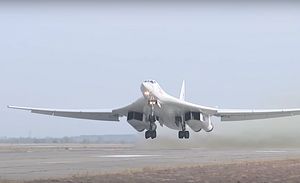Russia’s Strategic Forces conducted their annual readiness exercise that involved the test firing of air-launched cruise missiles, aero-ballistic missiles, and submarine-launched ballistic missiles on October 11.
“The exercises involved ground, naval and aviation strategic nuclear forces along with nuclear early-warning systems,” the Russian Ministry of Defense said in an October 11 statement. “Shifts on combat duty at command posts, combat crews of missile regiments, crews of nuclear-powered submarines of Northern and Pacific Fleets as well as pilots of strategic missile carriers and bombers practiced training actions.”
The ministry did not specify the types of aircraft, missiles, and submarines involved. However, based on videos released on the ministry’s website, it appears that the exercise involved Soviet-era Project 667BDR Kal’mar (Squid) Delta-III or Project 667 BDRM Delta IV-class nuclear-powered ballistic missile submarines (SSBN) armed with the R-29R/R-2S (NATO reporting name: SS-N-18 Stingray) submarine-launched ballistic missile (SLBM).
Interestingly, the routine exercise did not involve Russia’s most advanced SSBN armed with its latest SLBM, the Project 955 Borei-class (“North Wind”) aka Dolgoruky-class carrying the Bulava (RSM-56) ICBM — a sea-based variant of the Topol-M — capable of carrying up to ten warheads. (The Borei-class was also not part of last year’s exercise.)
All SLBM launches were purportedly detected by the EKS space-based early-warning system and early warning radars. “Single space system and ground-based radar stations promptly detected all ballistic missiles launched by submarines,” the statement reads. “Information on them was issued to the command posts of government and the Armed Forces in accordance with established procedure.”
The recently released videos also show a Tupolev Tu-22M3 bomber armed with a Rhaduga Kh-15 aero-ballistic missile, a Tupolev Tu-95MS bomber armed with the Kh-101/Kh-102 (nuclear variant) air-launched cruise missile (ALCM), and a supersonic Tupolev Tu-160 most likely also armed with a Kh-101/Kh-102 ALCM.
“Troops carried out combat training launches of submarine-launched ballistic missiles, air-based cruise missiles and aircraft-guided missiles from the waters of the Barents and Okhotsk seas, as well as long-range aircraft operating from Engels, Ukrainka and Shaykovka airfields,” according to the press release. “Objectives of the exercises were fulfilled. All training targets at the Kura, Chizha, Pemboi and Terekta test sites have been successfully engaged.”
Notably, the exercise did not involve the launch of ground-based intercontinental-range ballistic missiles (ICBM). Last year, the Strategic Forces fired four Topol-M ICBMs from the Plesetsk space center is located in Arkhangelsk Oblast. The Topol-M (aka RS12M2/NATO reporting name: SS-27), a three-stage solid fueled ICBM with a reported maximum range of 11,000 kilometers (6,835 miles).
The absence of any mention of an ICBM launch could point to a failed missile launch. The test firing could also have been cancelled for a number of technical reasons. Given the critical role that Russia’s ground-based ICBMs play in the country’s nuclear triad, it appears highly unlikely that the ICBMs were deliberately excluded from this year’s exercise. It is also possible that a launch did take place and the ministry of defense has chosen not reveal it to the public.
Notably, the exercise also tested Russian nuclear command and control systems. “The exercise tested the control system of the Armed Forces, as well as the reliability of combat training orders and signals through the whole chain of command from the National Centre for State Defense Control of the Russian Federation to the command posts of formations and military units,” the ministry notes.

































